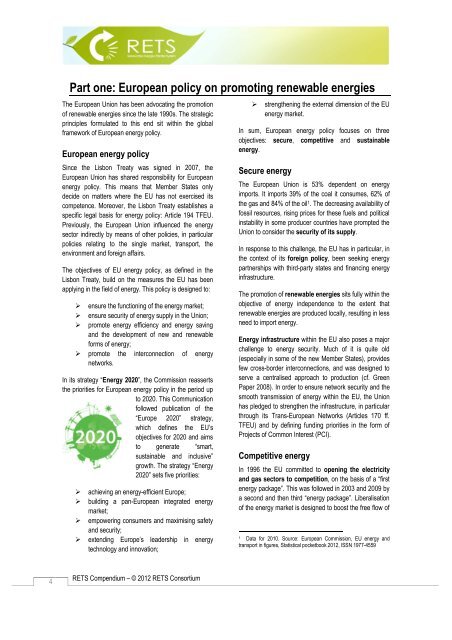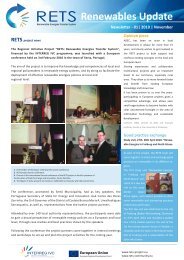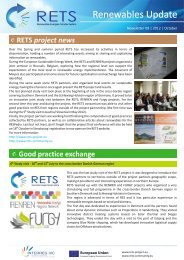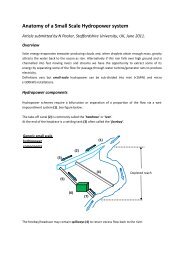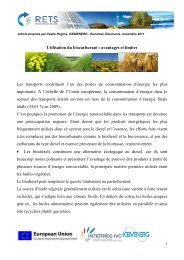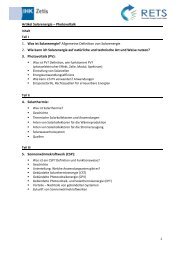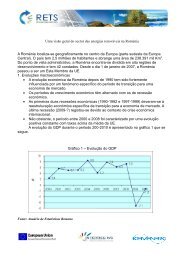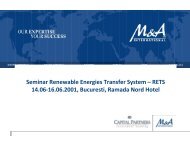Promoting renewable energies - RETS Project
Promoting renewable energies - RETS Project
Promoting renewable energies - RETS Project
Create successful ePaper yourself
Turn your PDF publications into a flip-book with our unique Google optimized e-Paper software.
Part one: European policy on promoting <strong>renewable</strong> <strong>energies</strong><br />
The European Union has been advocating the promotion<br />
of <strong>renewable</strong> <strong>energies</strong> since the late 1990s. The strategic<br />
principles formulated to this end sit within the global<br />
framework of European energy policy.<br />
European energy policy<br />
Since the Lisbon Treaty was signed in 2007, the<br />
European Union has shared responsibility for European<br />
energy policy. This means that Member States only<br />
decide on matters where the EU has not exercised its<br />
competence. Moreover, the Lisbon Treaty establishes a<br />
specific legal basis for energy policy: Article 194 TFEU.<br />
Previously, the European Union influenced the energy<br />
sector indirectly by means of other policies, in particular<br />
policies relating to the single market, transport, the<br />
environment and foreign affairs.<br />
The objectives of EU energy policy, as defined in the<br />
Lisbon Treaty, build on the measures the EU has been<br />
applying in the field of energy. This policy is designed to:<br />
ensure the functioning of the energy market;<br />
ensure security of energy supply in the Union;<br />
promote energy efficiency and energy saving<br />
and the development of new and <strong>renewable</strong><br />
forms of energy;<br />
promote the interconnection of energy<br />
networks.<br />
In its strategy “Energy 2020”, the Commission reasserts<br />
the priorities for European energy policy in the period up<br />
to 2020. This Communication<br />
followed publication of the<br />
“Europe 2020” strategy,<br />
which defines the EU’s<br />
objectives for 2020 and aims<br />
to generate “smart,<br />
sustainable and inclusive”<br />
growth. The strategy “Energy<br />
2020” sets five priorities:<br />
achieving an energy-efficient Europe;<br />
building a pan-European integrated energy<br />
market;<br />
empowering consumers and maximising safety<br />
and security;<br />
extending Europe’s leadership in energy<br />
technology and innovation;<br />
strengthening the external dimension of the EU<br />
energy market.<br />
In sum, European energy policy focuses on three<br />
objectives: secure, competitive and sustainable<br />
energy.<br />
Secure energy<br />
The European Union is 53% dependent on energy<br />
imports. It imports 39% of the coal it consumes, 62% of<br />
the gas and 84% of the oil 1 . The decreasing availability of<br />
fossil resources, rising prices for these fuels and political<br />
instability in some producer countries have prompted the<br />
Union to consider the security of its supply.<br />
In response to this challenge, the EU has in particular, in<br />
the context of its foreign policy, been seeking energy<br />
partnerships with third-party states and financing energy<br />
infrastructure.<br />
The promotion of <strong>renewable</strong> <strong>energies</strong> sits fully within the<br />
objective of energy independence to the extent that<br />
<strong>renewable</strong> <strong>energies</strong> are produced locally, resulting in less<br />
need to import energy.<br />
Energy infrastructure within the EU also poses a major<br />
challenge to energy security. Much of it is quite old<br />
(especially in some of the new Member States), provides<br />
few cross-border interconnections, and was designed to<br />
serve a centralised approach to production (cf. Green<br />
Paper 2008). In order to ensure network security and the<br />
smooth transmission of energy within the EU, the Union<br />
has pledged to strengthen the infrastructure, in particular<br />
through its Trans-European Networks (Articles 170 ff.<br />
TFEU) and by defining funding priorities in the form of<br />
<strong>Project</strong>s of Common Interest (PCI).<br />
Competitive energy<br />
In 1996 the EU committed to opening the electricity<br />
and gas sectors to competition, on the basis of a “first<br />
energy package”. This was followed in 2003 and 2009 by<br />
a second and then third “energy package”. Liberalisation<br />
of the energy market is designed to boost the free flow of<br />
1 Data for 2010. Source: European Commission, EU energy and<br />
transport in figures, Statistical pocketbook 2012, ISSN 1977-4559<br />
4<br />
<strong>RETS</strong> Compendium – © 2012 <strong>RETS</strong> Consortium


